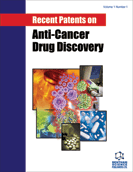
Abstract
The molecular chaperone heat shock protein 90 (HSP90) is essential for the folding stability, intracellular disposition and proteolytic turnover of many of the key regulators of cell growth, differentiation and survival. These essential functions are used by the cells during the oncogenesis process to allow the tumor transformation and facilitate the rapid somatic evolution. Inhibition of HSP90 would provide combinatorial blockade of a range of oncogenic pathways, antagonizing many of the hallmark traits of cancer. Several HSP90 inhibitors are currently under clinical trial investigation for the treatment of cancer. This review summarizes the current state and progress achieved in the development of HSP90 inhibitors targeting the N-terminal ATP pocket, C-terminal domain, different compartmentalized isoforms, and protein (cochaperones and/or client proteins)/HSP90 interactions. In the context of drug discovery, the most relevant patents which appeared recently in the literature are discussed as well.
Keywords: Anticancer therapeutics, development of antitumor agents, drug discovery, heat shock proteins (HSPs), HSP90 inhibitors, HSP90 modulators, heat shock response, molecular chaperones
Recent Patents on Anti-Cancer Drug Discovery
Title:Heat Shock Protein 90 Inhibitors as Therapeutic Agents
Volume: 7 Issue: 3
Author(s): Isabel Gomez-Monterrey, Marina Sala, Simona Musella and Pietro Campiglia
Affiliation:
Keywords: Anticancer therapeutics, development of antitumor agents, drug discovery, heat shock proteins (HSPs), HSP90 inhibitors, HSP90 modulators, heat shock response, molecular chaperones
Abstract: The molecular chaperone heat shock protein 90 (HSP90) is essential for the folding stability, intracellular disposition and proteolytic turnover of many of the key regulators of cell growth, differentiation and survival. These essential functions are used by the cells during the oncogenesis process to allow the tumor transformation and facilitate the rapid somatic evolution. Inhibition of HSP90 would provide combinatorial blockade of a range of oncogenic pathways, antagonizing many of the hallmark traits of cancer. Several HSP90 inhibitors are currently under clinical trial investigation for the treatment of cancer. This review summarizes the current state and progress achieved in the development of HSP90 inhibitors targeting the N-terminal ATP pocket, C-terminal domain, different compartmentalized isoforms, and protein (cochaperones and/or client proteins)/HSP90 interactions. In the context of drug discovery, the most relevant patents which appeared recently in the literature are discussed as well.
Export Options
About this article
Cite this article as:
Gomez-Monterrey Isabel, Sala Marina, Musella Simona and Campiglia Pietro, Heat Shock Protein 90 Inhibitors as Therapeutic Agents, Recent Patents on Anti-Cancer Drug Discovery 2012; 7 (3) . https://dx.doi.org/10.2174/157489212801820066
| DOI https://dx.doi.org/10.2174/157489212801820066 |
Print ISSN 1574-8928 |
| Publisher Name Bentham Science Publisher |
Online ISSN 2212-3970 |
 34
34
- Author Guidelines
- Graphical Abstracts
- Fabricating and Stating False Information
- Research Misconduct
- Post Publication Discussions and Corrections
- Publishing Ethics and Rectitude
- Increase Visibility of Your Article
- Archiving Policies
- Peer Review Workflow
- Order Your Article Before Print
- Promote Your Article
- Manuscript Transfer Facility
- Editorial Policies
- Allegations from Whistleblowers
Related Articles
-
Design and Synthesis of 1,4-dihydropyridine Derivatives as Anti-cancer Agent
Anti-Cancer Agents in Medicinal Chemistry Therapeutic Potential of Natural Compounds in Lung Cancer
Current Medicinal Chemistry Cellular Senescence in Ageing, Age-Related Disease and Longevity
Current Vascular Pharmacology Importance of Kier-Hall Topological Indices in the QSAR of Anticancer Drug Design
Current Computer-Aided Drug Design Cancer Stem Cells Equipped with Powerful Hedgehog Signaling and Better Epigenetic Memory: Avenues to Look for Cancer Therapeutics
Current Cancer Drug Targets Hydrophilic Interaction Liquid Chromatography Tandem Mass Spectrometry: An Attractive and Prospective Method for Quantitative Bioanalysis in Drug Metabolism
Current Drug Metabolism Chalcones as Versatile Synthons for the Synthesis of 5- and 6-membered Nitrogen Heterocycles
Current Organic Chemistry Rate Limiting Steps of AAV Transduction and Implications for Human Gene Therapy
Current Gene Therapy PET Tracers Based on Zirconium-89
Current Radiopharmaceuticals Computational Approaches for the Design of (Mutant-)Selective Tyrosine Kinase Inhibitors: State-of-the-Art and Future Prospects
Current Topics in Medicinal Chemistry Signal Transducer and Activator of Transcription 3 Signaling Pathway: A Potential Target in Sarcoma Treatment
Current Enzyme Inhibition A Comprehensive Review on the Importance of MiRNA-206 in the Animal Model and Human Diseases
Current Neuropharmacology DNA Methylation as a Target of Epigenetic Therapeutics in Cancer
Anti-Cancer Agents in Medicinal Chemistry Synthesis and Pharmacological Evaluation of Maleopimaric N-arylimides: Identification of Novel Proapoptotic Agents
Anti-Cancer Agents in Medicinal Chemistry RNA Splicing: Basic Aspects Underlie Antitumor Targeting
Recent Patents on Anti-Cancer Drug Discovery Molecular Targeted Agents Combined with Chemo-Radiation in the Treatment of Locally Advanced Cervix Cancer
Reviews on Recent Clinical Trials Differentiation of High-grade Gliomas from Brain Metastases Using Tissue Similarity Maps (TSMs) Based Relative Cerebral Blood Volume Values
Current Medical Imaging Arylpyrazoles: Heterocyclic Scaffold of Immense Therapeutic Application
Current Organic Chemistry Magnetic Nanoparticles: Properties, Synthesis and Biomedical Applications
Current Drug Metabolism Recent Progress on the Mangrove Plants: Chemistry and Bioactivity
Current Organic Chemistry
























